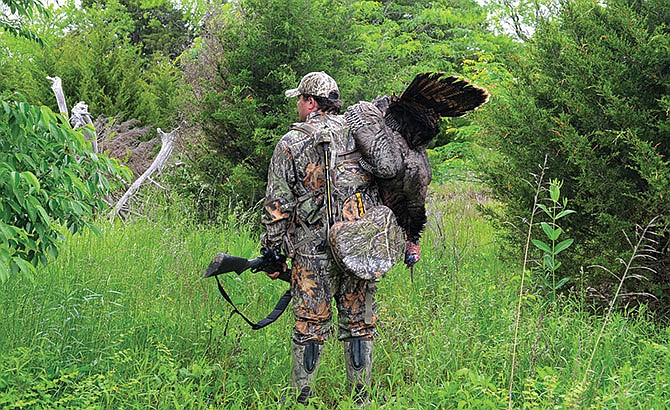Turkey hunting isn't as complicated as it may appear.
To a newcomer, you may feel overwhelmed by what you read in magazines or watch on television. Really, it comes down to concealment, calling and shot placement. Having the right equipment can make or break a turkey season.
Here is a list of items that will stack the odds of success in your favor this spring.
Clothes
Camouflage clothing is important when turkey hunting.
Turkeys have excellent eyesight and see in color. They are also very keen at detecting motion. Being covered from head to toe in a camouflage pattern that blends with your surroundings helps you remain undetected by wary gobblers. This includes wearing a facemask and gloves.
Spring weather is often unpredictable, so be sure to have a collection of clothes adequate for a wide range of temperatures and conditions. Rain is common during spring turkey season, so a rain jacket or poncho is a wise investment.
The grass is usually wet with dew in the morning and the smallest of creeks can quickly fill with rushing water, so knee-high rubber boots are the way to go.
Vest
Sure, you can carry a backpack or fanny pack, but the most convenient way of storing, organizing and accessing your turkey-hunting equipment in the field is a turkey-hunting vest.
There are many models available, from the very basic with a few pockets, to technologically advanced systems with built in hydration packs or back support poles. The right vest for you should have enough pockets to keep all your gear secure, without being too bulky when moving through the woods.
Calls
With so many different calls on the market, choosing one style over another can be overwhelming to a beginning turkey hunter.
Mouth calls, slate calls, box calls, push-button calls, wing bone calls and locator calls all have their place in the grand scheme of turkey calling, but when you're first learning, box calls and push-button calls are the easiest to use.
Practice is important before hitting the woods. Even with the simplest call in hand, you still need to produce a realistic sound. Many training DVDs and CDs are available, or you can search calling tips online. There are thousands of videos on YouTube.
Nothing compares to learning from the real thing, though. Spend time in the woods just listening for turkeys. Eventually, you'll hear clucks, putts, cackles, cutts, purrs, yelps, kee kees, gobbles and more. Don't worry about knowing the difference in the beginning. Work on producing clucks and yelps. These two calls have led to the demise of more gobblers than all the rest combined.
Shotgun and Ammo
You can kill a turkey with just about any shotgun made, but 12- and 20-gauge pumps are most commonly used.
Single shots, double-barrels and semi-automatics will also do the job. What is most important is being accurate with the gun you carry. A special turkey choke helps significantly.
A turkey choke tightens your load of pellets for an extended range, meaning more pellets hit the target down range. When shooting a turkey, aim for the head. A tighter group allows you to shoot turkeys further away. A 40-yard shot is a long one. I caution you not to try shots any further than that.
There are many different specialized turkey loads on the market available in different load size and shell length. A longer shell usually holds more powder and pellets than shorter ones. Shot sizes of 4, 5 and 6 are all adequate and commonly used.
Conclusion
There are many more pieces of equipment you can carry with you to the turkey woods that will help you find success, but these basics are all you really need.
A good pair of binoculars, insect repellent and a good cushion to sit on are a few more items I never leave behind.
See you down the trail. ...
Brandon Butler, the executive director of the Conservation Federation of Missouri, is an outdoors columnist for Central Missouri Newspapers Inc. Contact him at [email protected].

